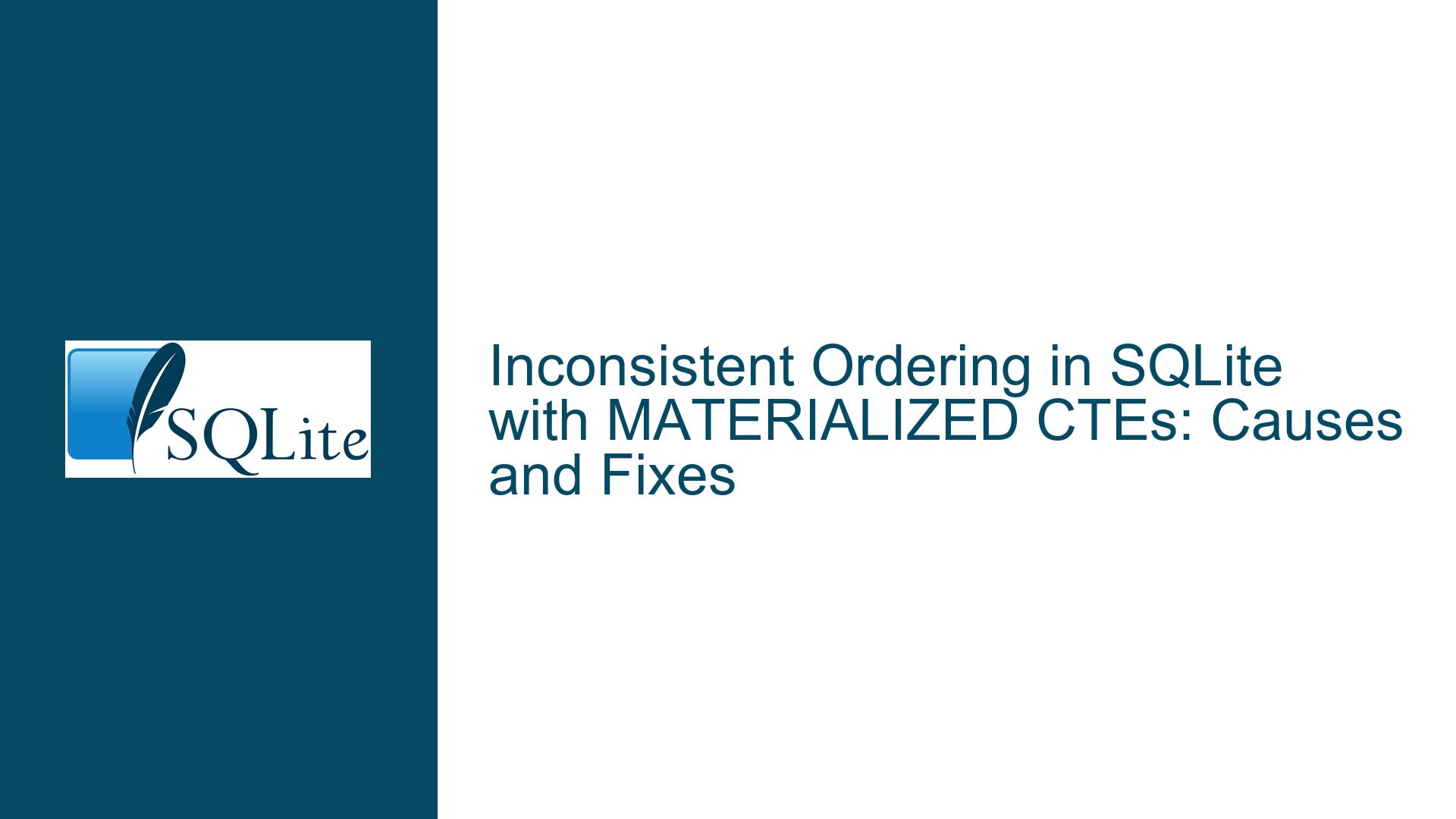Inconsistent Ordering in SQLite with MATERIALIZED CTEs: Causes and Fixes
Issue Overview: Inconsistent Ordering with MATERIALIZED CTEs in SQLite
When working with Common Table Expressions (CTEs) in SQLite, particularly when using the MATERIALIZED keyword, developers may encounter unexpected behavior in the ordering of results. This issue arises when the ordering specified within a CTE is not preserved when the CTE is materialized. The problem is subtle and can be difficult to diagnose because it often depends on the specific structure of the query and the data involved.
In the provided example, a query is constructed using multiple CTEs, with the final CTE (d) performing a join operation and explicitly ordering the results by a column named index. When the CTE d is not materialized, the ordering is preserved, and the query returns the expected results. However, when the MATERIALIZED keyword is added to the CTE d, the ordering is lost, and the results are no longer consistent with the specified ORDER BY clause.
This inconsistency is particularly puzzling because the MATERIALIZED keyword is intended to optimize query performance by storing the results of the CTE in a temporary table. However, in this case, it appears to interfere with the expected ordering of the results. The issue is further complicated by the fact that slight modifications to the query, such as removing the outer FROM i clause, can restore the correct ordering, even when the MATERIALIZED keyword is present.
Possible Causes: Why MATERIALIZED CTEs Disrupt Ordering
The root cause of this issue lies in how SQLite handles the materialization of CTEs and the interaction between the query planner and the ordering of results. When a CTE is materialized, SQLite creates a temporary table to store the results of the CTE. This temporary table is then used in subsequent parts of the query. However, the process of materialization can sometimes lead to the loss of ordering information, especially when the ordering is not explicitly enforced in the final SELECT statement.
One key factor contributing to this issue is that SQLite’s query planner has significant flexibility in how it executes queries. The MATERIALIZED keyword is treated as a hint rather than a strict directive, meaning that the query planner may choose to ignore it in certain circumstances. This flexibility can lead to unpredictable behavior, particularly when dealing with complex queries involving multiple joins and ordering clauses.
Another factor is that the ordering specified within a CTE is not always carried over to the final result set. In SQLite, the ORDER BY clause within a CTE only affects the order of rows within that CTE. If the final SELECT statement does not explicitly include an ORDER BY clause, SQLite is free to return the rows in any order it deems most efficient. This behavior is consistent with the SQL standard, which does not guarantee the order of results unless an ORDER BY clause is present in the outermost query.
In the provided example, the ORDER BY clause within the CTE d is effectively ignored when the CTE is materialized. This is because the materialization process creates a temporary table that does not preserve the ordering of the rows. When the final SELECT statement retrieves data from this temporary table, the rows are returned in an arbitrary order, leading to the observed inconsistency.
Troubleshooting Steps, Solutions & Fixes: Ensuring Consistent Ordering with MATERIALIZED CTEs
To address the issue of inconsistent ordering with MATERIALIZED CTEs in SQLite, developers can take several steps to ensure that the desired ordering is preserved. These steps involve modifying the query structure, explicitly enforcing ordering at the appropriate level, and understanding the behavior of the SQLite query planner.
1. Explicitly Enforce Ordering in the Final SELECT Statement
One of the most straightforward solutions is to ensure that the final SELECT statement includes an ORDER BY clause. This approach guarantees that the results are returned in the desired order, regardless of whether the CTE is materialized or not. In the provided example, the final SELECT statement could be modified as follows:
WITH i AS (
VALUES (1), (2), (3)
),
a("id", fk) AS (
VALUES ("a", 0)
),
aa("id", fk) AS (
VALUES (0, 0)
),
b("key", sk) AS (
VALUES (0, "aa")
),
c("key", "index", title) AS (
VALUES (0, 1, "a"), (0, 0, "b")
),
d(sk, title) AS MATERIALIZED (
SELECT
b.sk,
title
FROM
a
INNER JOIN aa ON aa."id" = a.fk
INNER JOIN b ON b."key" = aa.fk
LEFT JOIN c ON c."key" = aa.fk
ORDER BY c."index"
)
SELECT (
SELECT title
FROM d
WHERE sk = 'aa'
ORDER BY title -- Explicitly enforce ordering here
LIMIT 1
) FROM i;
By adding the ORDER BY title clause to the final SELECT statement, the results will always be returned in the correct order, even if the CTE d is materialized.
2. Avoid Materialization When Ordering is Critical
If preserving the order of results is critical, and materialization is not strictly necessary, developers can choose to avoid using the MATERIALIZED keyword altogether. In many cases, SQLite’s query planner will optimize the query effectively without the need for explicit materialization. By removing the MATERIALIZED keyword, the query will rely on the default behavior of the query planner, which may preserve the ordering more reliably.
WITH i AS (
VALUES (1), (2), (3)
),
a("id", fk) AS (
VALUES ("a", 0)
),
aa("id", fk) AS (
VALUES (0, 0)
),
b("key", sk) AS (
VALUES (0, "aa")
),
c("key", "index", title) AS (
VALUES (0, 1, "a"), (0, 0, "b")
),
d(sk, title) AS ( -- No MATERIALIZED keyword
SELECT
b.sk,
title
FROM
a
INNER JOIN aa ON aa."id" = a.fk
INNER JOIN b ON b."key" = aa.fk
LEFT JOIN c ON c."key" = aa.fk
ORDER BY c."index"
)
SELECT (
SELECT title
FROM d
WHERE sk = 'aa'
LIMIT 1
) FROM i;
In this modified query, the MATERIALIZED keyword is omitted, allowing the query planner to handle the CTE d in a way that may better preserve the ordering.
3. Use Subqueries or Temporary Tables to Preserve Ordering
In some cases, it may be necessary to use subqueries or temporary tables to ensure that the ordering is preserved. This approach involves breaking the query into smaller parts and explicitly storing intermediate results in a temporary table. By doing so, developers can enforce the desired ordering at each step of the query.
-- Create a temporary table to store the ordered results
CREATE TEMPORARY TABLE temp_d AS
SELECT
b.sk,
title
FROM
a
INNER JOIN aa ON aa."id" = a.fk
INNER JOIN b ON b."key" = aa.fk
LEFT JOIN c ON c."key" = aa.fk
ORDER BY c."index";
-- Use the temporary table in the final SELECT statement
WITH i AS (
VALUES (1), (2), (3)
)
SELECT (
SELECT title
FROM temp_d
WHERE sk = 'aa'
LIMIT 1
) FROM i;
-- Drop the temporary table after use
DROP TABLE temp_d;
In this example, the results of the join operation are stored in a temporary table temp_d with the desired ordering. The final SELECT statement then retrieves data from this temporary table, ensuring that the ordering is preserved.
4. Understand and Leverage SQLite’s Query Planner Behavior
Finally, developers should take the time to understand the behavior of SQLite’s query planner and how it interacts with CTEs and the MATERIALIZED keyword. By gaining a deeper understanding of the query planner’s behavior, developers can make more informed decisions about when and how to use materialization, and how to structure their queries to achieve the desired results.
In conclusion, the issue of inconsistent ordering with MATERIALIZED CTEs in SQLite can be addressed through a combination of explicit ordering, careful query design, and a thorough understanding of the query planner’s behavior. By following the steps outlined above, developers can ensure that their queries return consistent and correctly ordered results, even when using materialized CTEs.






